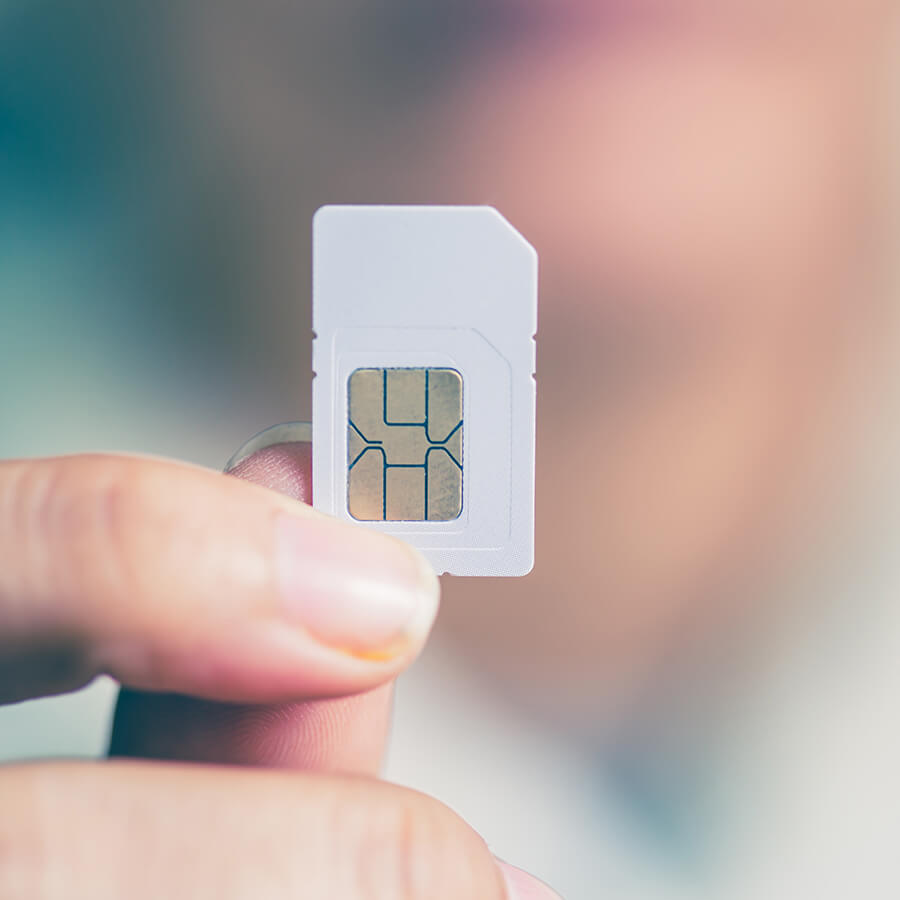Complete guide to SIM cards
 Dan Howdle • August 28th, 2024
Dan Howdle • August 28th, 2024

Mobile phones are integral to our daily lives. From shopping and staying connected with loved ones to running businesses on the go, we rely on our phones for a wide range of activities.
Despite our reliance on mobile phones, many of us don't fully understand how they work—especially when it comes to the small, yet powerful SIM card. This guide will explain everything you need to know about SIM cards, from what they are to how they function, and how to choose the right one for your needs.
What is a SIM card?
A SIM card, or Subscriber Identity Module, is a small chip that plugs into your mobile device, enabling it to connect to a mobile network. Despite its size, a SIM card holds crucial information, including your phone number, the services you subscribe to, and the security details needed to access your network. Without a SIM card, your device can't make calls, send texts, or access mobile data.

A SIM card also stores your contacts and SMS messages, although with the advent of cloud storage, fewer people rely on SIM storage for these purposes. Modern SIM cards are equipped with a PIN (Personal Identification Number) to secure access and a PUK (Personal Unblocking Key) to reset your PIN if needed.
Devices that use SIM cards aren't limited to mobile phones. You’ll find SIMs in tablets, smartwatches, mobile Wi-Fi devices (like MiFis), and even some laptops, cameras, and cars.
What are the different types of SIM cards?
SIM cards have evolved over the years, shrinking in size while retaining their capabilities. Today, there are four main types of SIM cards available:
SIM card types by size
SIM cards come in three physical sizes: standard, micro, and nano, along with a newer, embedded option called an eSIM. The type you need depends on the age and model of your device.
- Standard SIM cards – The largest size, mainly found in older phones. These are now largely obsolete.
- Micro SIM cards – Smaller than standard SIMs, micro SIMs were common in phones released in the early 2000s but are now also being phased out.
- Nano SIM cards – The smallest and most common type, used in most modern smartphones.
- Combi SIMs – A single card that includes all three sizes (standard, micro, and nano). You can pop out the size you need, making it versatile for different devices.
- eSIMs – An embedded SIM that is built into the device itself. eSIMs are becoming increasingly popular, especially in newer smartphones like the iPhone and high-end Android devices. They allow you to switch networks without needing a physical SIM card.
Different SIMs have different uses
The type of SIM card you need will depend on your device and how you plan to use it.
Mobile phone SIMs
Mobile phones are the most common devices that use SIM cards. The SIM links your phone to your mobile network, enabling you to make calls, send texts, and use mobile data. If you damage your phone, you can transfer your SIM to another device, as long as it’s the right size.
Data-only/tablet SIMs
Data-only SIMs are used in tablets, laptops, and mobile Wi-Fi devices. These SIMs provide internet access but don’t allow for calls or texts. They’re ideal for devices that are primarily used for browsing the web, streaming, or using apps that require internet connectivity. Data-only SIMs are widely available from all major mobile providers, often with unlimited or bundled data plans.
MiFi SIMs
A MiFi device is a portable Wi-Fi router that uses a data-only SIM card to create a mobile internet hotspot. This is useful when you need a reliable internet connection on the go, especially in areas where Wi-Fi isn’t available. Simply insert a data-only SIM card into the MiFi device, and you can connect multiple devices to the internet just like you would with a home Wi-Fi network.
Car SIMs
Some newer cars come with SIM card slots to provide an internet connection for on-board systems. These SIMs can enable real-time traffic updates, GPS services, and in-car apps, helping you stay connected while on the road. You can also use these SIMs to create a Wi-Fi hotspot in your car.
How to insert your SIM card
Inserting a SIM card is straightforward, but the process can vary slightly depending on your device.
Mobile phones
Most modern smartphones have a SIM card tray on the side of the device. To insert your SIM, first, turn off your phone. Use a SIM ejector tool (or a paperclip) to push into the small hole next to the SIM tray. The tray will pop out, allowing you to place your SIM card inside. The SIM card has a small notch to guide you, ensuring it’s inserted correctly. Once the SIM is in place, push the tray back into the phone and turn it on.
Tablets
Inserting a SIM card into a tablet is similar to the process for mobile phones. Some tablets have a SIM slot under the battery cover, while others use a tray similar to smartphones. Check your device’s user manual if you’re unsure where the SIM slot is located.
MiFi devices
To insert a SIM card into a MiFi device, turn off the device and locate the SIM slot, which is usually under the battery cover. Insert the SIM card with the gold contacts facing down, following the outline on the device. Once the SIM is in place, replace the battery and cover, then turn the device back on.
Car SIMs
If your car has a SIM card slot, it will likely be located near the dashboard or integrated GPS system. To insert the SIM, make sure the car is parked safely, then insert the SIM card into the slot with the gold contacts facing down. Follow any on-screen prompts that appear on your car’s display to complete the setup.
How to activate your SIM card
Activating a SIM card is a straightforward process, but it can vary slightly depending on your provider and the type of SIM you have.
Mobile phone SIMs
For most mobile phone SIM cards, activation occurs automatically when you insert the SIM into your phone and turn it on. If you’ve signed up for a new plan or switched providers, your phone should connect to the network within a few minutes. If your SIM doesn’t activate automatically, you may need to contact your provider’s customer service for assistance.
Data-only SIMs
Data-only SIM cards often require online activation. When you receive your SIM, it will come with instructions from your provider, including a link to an activation page. You’ll typically need to enter your SIM card number and some personal details. Once activated, insert the SIM into your device, turn it on, and you should be connected.
MiFi devices
To activate a SIM card in a MiFi device, follow the same online activation process as for data-only SIMs. Once activated, insert the SIM into the MiFi device, turn it on, and your portable Wi-Fi should be ready to use.
Car SIMs
Car SIM activation can vary depending on the vehicle and provider. Some car SIMs activate automatically when inserted, while others may require online or phone activation. Follow the instructions provided with your SIM or consult your car’s manual for specific activation steps.
